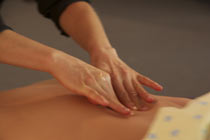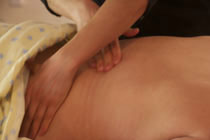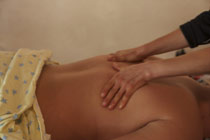Swedish Massage
The History of Swedish Massage
 Pehr Henrik Ling (1776-1839), a prominent Swedish medical-gymnastic practitioner influenced by Chinese martial arts and "Tuina" medical techniques ("a Chinese hands-on-body treatment"), combined Chinese features with early 19th century sports medicine and created a "Medical Gymnastics" system for "relieving sore muscles, increasing flexibility and promoting general health". This combination spawned the origin of "Swedish Massage" (Fleming, 2009; Calvert, 2010).
Pehr Henrik Ling (1776-1839), a prominent Swedish medical-gymnastic practitioner influenced by Chinese martial arts and "Tuina" medical techniques ("a Chinese hands-on-body treatment"), combined Chinese features with early 19th century sports medicine and created a "Medical Gymnastics" system for "relieving sore muscles, increasing flexibility and promoting general health". This combination spawned the origin of "Swedish Massage" (Fleming, 2009; Calvert, 2010).
Ling's theories and practice were then popularized by a Dutch physician, Johann Georg Mezger (1838-1909), who played an important role in legitimizing Ling's techniques in the public (Calvert, 2010). He simplified the movements based on the gymnastics developed by Ling and categorized the methods of soft tissue manipulation into four broad technique categories using the French terms "effleurage (long and gliding strokes), petrissage (lifting and kneading the muscles), friction (firm, deep, circular rubbing movements), and tapotement (brisk tapping or percussive movements)" (Oils and Plants). Vibration (rapidly shaking or vibrating specific muscles) was added later as a fifth technique category when Swedish massage gained popularity in the late 1800s (Oils and Plants; Benjamin & Tappan, 2004).
The movements became well known as "Swedish movements" in Europe and as "the Swedish Movement Cure" when the practice arrived in the U.S. in 1858 (Benjamin & Tappan, 2004). Dr. George Taylor of New York, Hartvig Nissen in Washington, DC, Baron Nils Posse in Boston, Kurre Ostrom in Philadelphia, and Axel Grafstrom in New York are outstanding figures in the early history of the movement cure of the United States(Benjamin & Tappan, 2004). By the early 20th century, Mezger's massage style was adopted by practitioners of the Swedish movement cure (Benjamin & Tappan, 2004).
Today Swedish Massage involves a variety of techniques aiming at relaxing "muscles by applying pressure to them against deeper muscles and bones, and rubbing them in the same direction as the flow of blood returning to the heart" (The Alexander Touch). Most massage practiced in the West is at least to some degree derived from Ling's original work (Ury, 2009).
What Is Swedish Massage?
 Swedish Massage is the most common type of massage in the western world involving "a variety of strokes and pressure techniques that are used to enhance the flow of blood to the heart, remove toxins from muscles, stretch ligaments and tendons, ease physical and emotional tension" and ultimately energize the body (University of Maryland Medical Center). Swedish massage is based on the western concepts of anatomy and physiology as opposed to energy work which is more common in Asian-style massage (University of Maryland Medical Center).
Swedish Massage is the most common type of massage in the western world involving "a variety of strokes and pressure techniques that are used to enhance the flow of blood to the heart, remove toxins from muscles, stretch ligaments and tendons, ease physical and emotional tension" and ultimately energize the body (University of Maryland Medical Center). Swedish massage is based on the western concepts of anatomy and physiology as opposed to energy work which is more common in Asian-style massage (University of Maryland Medical Center).
Basic Massage Techniques
Swedish Massage uses five basic movements to increase circulation and remove toxins from muscles (Ury, 2009). The therapist uses "firm but gentle pressure" to compress and relax muscles, with strokes always flowing to the direction of the heart and help of oil to reduce friction (Ury, 2009).
 The five basic techniques are (Ury, 2009; Strictly Therapeautic):
The five basic techniques are (Ury, 2009; Strictly Therapeautic):
Effleurage: Long gliding strokes with the palms, thumbs and/or fingertips whose pressure varies depending on the therapist and the client. Smoothing strokes are used for "spreading lotion or oil on the body" and "helping the therapist evaluate muscle tension". With the pressure of the strokes increasing, those strokes are able to provide a stretch to the muscles, therefore allowing the client to relax.
Petrissage: "Kneading, rolling, squeezing and lifting movements designed to relax muscles and increase circulation by compressing and releasing muscle tissue" with the hands, thumbs and/or fingers.
Tapotement: "Tapping muscles with the side of the hand, fingers or palm to release tension and cramping".
Vibration: "Using hands or a machine to create rapid movement that relaxes and soothes muscles".
Friction: "A strong, rapid, circular movement usually done to release muscle knots" with the palms of hands, thumbs and/or fingers. Generally, friction is applied for only a short time so as to "avoid an inflammatory response".
Health Benefits
Swedish massage is relaxing and invigorating (Mamas Health). It helps the body get relaxed and achieve a sense of overall well-being by "affecting the nerves, muscles, glands, and circulation".
Valerie Broas, a licensed massage therapist, is currently teaching Swedish Massage at the Florida School of Massage. She has more than ten years of experience in teaching and practicing Swedish Massage. She talks about the health benefits of Swedish Massage:
